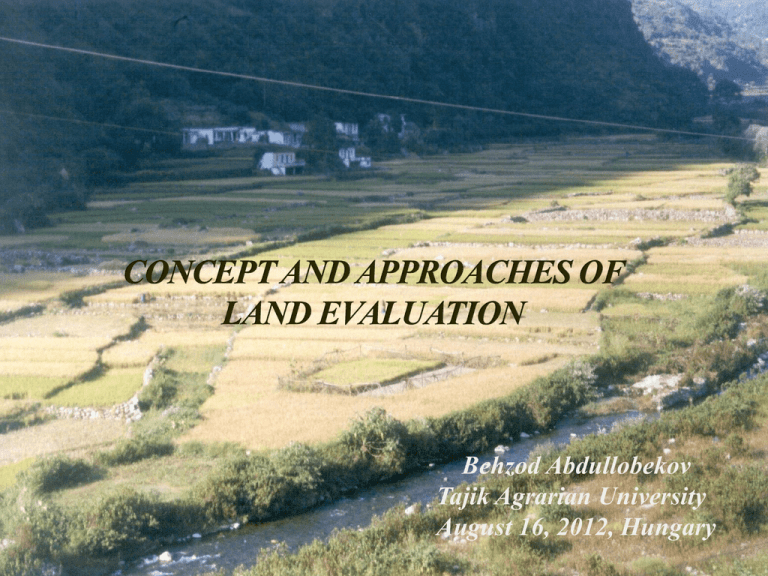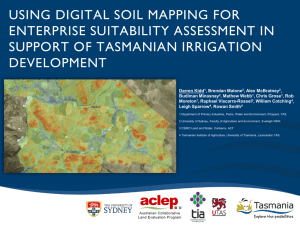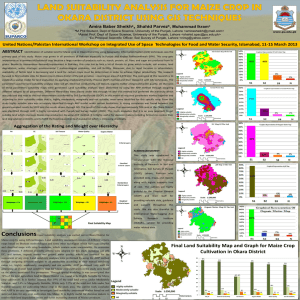Land Evaluation
advertisement

Behzod Abdullobekov Tajik Agrarian University August 16, 2012, Hungary Lecture content Land evaluation procedure Land capability classification Land productivity index Land evaluation is aimed at assessment of land performance and its production potential for a specific purpose. Land evaluation is only part of the process of land use planning. The function of land use planning is to guide decisions on land use in such a way that resources of the environment are put to most beneficial use for man, whilst at same time conserving those resources for future. the the the the Land-use requirements match Land qualities suitability Land-use planning policies & plans Land Capability Classification Soil and Land Irrigability Classification Parametric methods Land Productivity Index Soil Productivity Index There are eight capability classes Class I to class IV : Arable land (suitable for cultivation) Class V to class VIII: Non-arable land (unsuitable for cultivation) The subclass are based on kinds of dominant limitation such as wetness or excess water (w), Climates (c) and erosion (e) Land Productivity Index (LPI)= A*B*C*X*Y Where factors are decimal equivalents of percentage ratings. A = General characteristics of soil profile B =Texture of the surface soil C = Slope of the land X = Miscellaneous factors; reaction of surface soil, fertility, erosion Y = Average annual rainfall The suitability of land for irrigation depends on physical factors like quality and quantity of irrigation water and socio-economic factors like land development costs provision of drainage facilities production costs of individual crops. Class Definition Class 1 Lands that have few limitations of soils, topography or drainage for sustained use under irrigation. Class 2 Lands that have moderate limitations of soil, topography or drainage for sustained use under irrigation. Class 3 Lands that have severe limitations of soil, topography or drainage for sustained use under irrigation. Class 4 Lands that are marginal for sustained use under irrigation because of very severe limitations of either soil topography or drainage. Class 5 Lands that are temporarily classed as not suitable for sustained use under irrigation. Class 6 Lands not suitable for sustained use under irrigation. In the FAO land evaluation procedure, land qualities/land characteristics of each land unit are compared with land use requirements (LURs) to obtain an overall suitability assessment of the land unit for each of land utilization types (LUTs) FAO Framework classification describe the suitability of an evaluation unit for a land use in four categories, - Order - Class - Sub-class - Unit Assess land suitability based on: the requirements of specific land uses a comparative analysis of inputs vs. benefits: multi-disciplinary the physical, economic and social context potential environmental impacts & sustainability Local to global scales, highly populated to undeveloped areas, qualitative vs. quantitative. (1) Suitability orders All land is divided into two suitability orders, according to whether the land is suitable or not for a given LUT. 'S' = suitable, 'N' = not suitable, for the land use. (2) Suitability classes These are divisions of suitability orders that indicate the degree of suitability, not simply suitable vs. not suitable. 'S1' = suitable, 'S2' = moderately suitable, 'S3' = marginally suitable, 'N1' unsuitable for economic reasons but otherwise marginally suitable, 'N2' = unsuitable for physical reasons. N3 implies limitations that are not correctable at any cost within the context of the land utilization type. Shurobod Vose district Cadastral boundary Consultation •Objectives •Assumptions •LU options Land-use requirement Interim match LUT Land qualities Land mapping Unit Interim Suitability Assessment classification system Final Suitability Assessment •land improvements •environmental impacts •Social and economic analyses Agricultural development planning Irrigation suitability assessment Population supporting capacity Agricultural technology transfer Land degradation risk assessment Land Evaluation Livestock forage balance assessment Environmental impact assessment Agricultural inputs recommendations Student tasks Topic: To do restorative plan the land cadastre map Practices material : Old cadastre map of Khatlon region. Check the accuracy of updating Report of procedure Reference/











